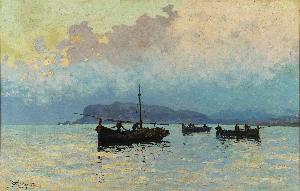Michele Catti
Michele Catti
Place: Palermo
Born: 1855
Death: 1914
Biography:
Michele Catti was a renowned Italian artist, considered one of the most important Sicilian landscape painters of the Belle Époque. Born in Palermo in 1855, Catti died in the same city in 1914, leaving behind a legacy of breathtaking paintings that captured the essence of Sicily's landscapes and seascapes.
Early Life and Training
Catti's early life was marked by a desire to pursue a career in law, but his passion for art soon took over. He began his artistic training under the guidance of Francesco Lojacono, a prominent Sicilian landscape painter. Lojacono's influence had a significant impact on Catti's style, which was characterized by a deep sense of lyricism and a ability to capture the play of light on the Sicilian landscape.
Artistic Career
Catti's artistic career was marked by a series of exhibitions and commissions that showcased his talent. In 1875, he participated in the exhibition organized in Montevergini, where his painting Burrasca d’autunno was considered one of the most beautiful works of the exhibition. This success was followed by a series of commissions, including the ceiling decoration of the Teatro Massimo of Palermo, which he worked on from 1893 to 1897. Catti's paintings are characterized by a deep sense of color and a ability to capture the mood of the Sicilian landscape. His use of light and shadow created a sense of depth and atmosphere, drawing the viewer into the world of his paintings. Some of his notable works include La Collezione Bonello, which is now part of the collection at the National Museum of Fine Arts in La Valletta, Malta.
Influences and Legacy
Catti's work was influenced by a range of artists, including Francesco Lojacono and Antonio Leto. He was also part of a group of Sicilian landscape painters, known as the "canonical triad" of the Belle Époque, which included Francesco Lojacono and Antonio Leto. This group was known for their ability to capture the essence of the Sicilian landscape, and Catti's work was a significant contribution to this movement. Today, Catti's paintings can be found in museums and private collections around the world, including the Museum Gipsoteca Antonio Canova in Possagno, Italy. His legacy continues to inspire artists and art lovers alike, and his paintings remain a testament to the beauty and power of the Sicilian landscape.
- Some of Catti's notable works can be found on Wikioo.org, including La Croce di Santa Maria di gesu, Palermo and View Of Acquasanta, Palermo.
- More information about Catti's life and work can be found on Wikipedia.
- Catti's paintings are also featured in the Collezione Bonello, which can be found on Wikioo.org.
and Antonio Leto were also influential artists of the Belle Époque, and their work can be found on Wikioo.org and Wikioo.org.





